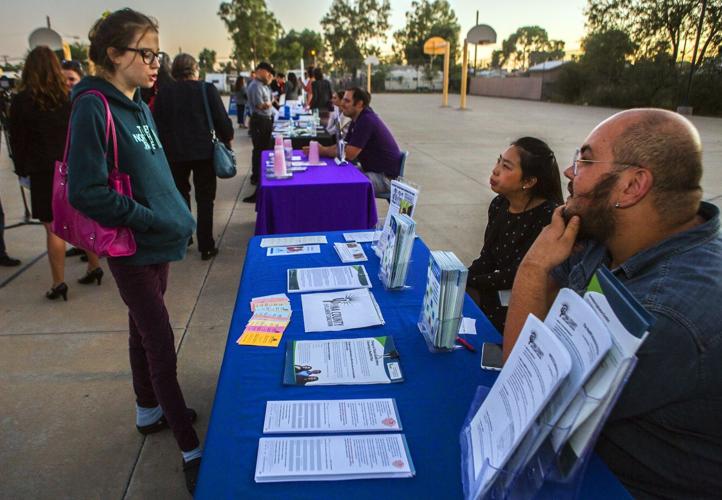Arizonans should be prepared for fewer choices and more HMOs when buying insurance on the federal health exchange this enrollment season.
The third annual open enrollment for Arizonans to purchase what is often called “Obamacare” health insurance on the federal marketplace begins Sunday, Nov. 1, and continues through Jan. 31, 2016.
Enrollment for the health exchanges should not be confused with Medicare enrollment, which began Oct. 1 and goes through Dec. 7.
Obamacare insurance purchased through the exchanges is for working-age people. Most Arizonans who bought insurance through the insurance exchange last year qualified for federal subsidies to help them pay for it.
Here’s what Arizonans need to know about Obamacare and the health-insurance exchanges.
- If you choose to go without health insurance in 2016, be prepared to pay a hefty fine.
The Patient Protection and Affordable Care Act passed by Congress mandates that all Americans have health insurance. Fines began in 2014 and have been gradually increasing.
In 2016, the uninsured face paying whichever is the highest of two amounts: — 2.5 percent of your yearly household income or $695 per person ($347.50 per child under 18). During the first year of mandatory health insurance, the penalty was the higher of $95 or 1 percent of your yearly income.
- Arizonans purchase their insurance on the federal exchange.
Some states like California chose to create their own state-based exchanges. Arizona opted to use the federal exchange. The website is healthcare.gov and the toll-free phone number is 1-800-318-2596 (TTY: 1-855-889-4325).
The exchange sells private insurance policies, and depending on income, consumers may qualify for subsidies to pay for it.
- Most Americans don’t get their health insurance via the exchange.
If you are on Medicaid, Medicare (or any government insurance) or have employer-sponsored insurance, you don’t need to use the exchange.
- There are more HMO (health management organization) plans this year.
Major insurers, in an effort to keep plans affordable for consumers, are increasingly shifting to HMO offerings on the health exchange.
Blue Cross Blue Shield of Arizona is switching out all of its individual PPO (preferred provider organization) insurance exchange individual plans to HMOs, excluding grandfathered plans.
Statewide, 37,000 people will be affected. All affected consumers have been notified via a letter, said Jeff Stelnik, senior vice president of Blue Cross Blue Shield of Arizona.
Similarly Meritus, an Arizona insurance company, is not offering any individual PPO plans on the health insurance exchange this year — only HMOs.
“We will offer it off exchange, available to consumers without a subsidy,” Meritus chief operations officer Jim Walsh said. “The ability for a consumer to have a PPO plan is really going to be pretty limited.”
Both Walsh and Stelnik say higher-than-anticipated PPO costs in the past two years have driven a nationwide trend of more HMO plans.
“The PPO plans are just not performing well, and when a few big players like Blue Cross pull out it makes it difficult for anyone else to stay in,” Walsh said.
The disadvantage to HMOs is that they are narrower networks. That means they include only certain doctors, so if your longtime primary care physician is not in the network, you’ll need a new doctor. Also, some HMO plans require a primary-care referral to a specialist (though not to an ob/gyn). Emergency care is always covered outside of the network.
Blue Cross Blue Shield of Arizona has set up a website to help answer questions about HMOs and PPOs: AZBlue.com/GetIn
- Arizonans will have fewer options for plans this enrollment season.
Last year there were 13 insurance companies offering plans for Arizonans on the health exchange. Fewer companies and fewer plans are expected this season.
“Some of that I think is a bit of a positive. I think there were too many choices in the last couple of years and that just made it overly confusing for the consumer,” Walsh said.
- The federal subsidies can help keep monthly premiums down.
“Many people are still unaware there is financial assistance,” said Damian Alzua, deputy regional director for Enroll America in Southern Arizona. “That’s the biggest misconception out there.”
It doesn’t happen often, but some Arizonans have been able to buy insurance on the exchange and owe no monthly premium once the subsidy is factored in. In any case, the federal subsidies can significantly reduce the monthly premium.
Plan premiums in Pima County, without federal subsidies, begin at about $112 per month for a 25-year-old nonsmoker who purchases the cheapest “catastrophic plan,” according to 2016 premium rates for individual HMO and PPO federally qualified health plans filed with the Arizona Department of Insurance.
Prices go up and vary depending on age, whether one is a smoker, and according to the level of plan — bronze, silver, gold or platinum, with platinum being the most comprehensive and expensive.
But premiums should not be the only factor people consider when they buy a plan — networks and deductibles are also important and could affect overall cost.
- Consumers should never have to pay money to get help enrolling in a plan via the health insurance exchange.
Local “navigators” and “certified enrollment assisters” are available free of charge to help. They do not receive a commission for enrolling people, and they must be unbiased and have no conflicts of interest. They can also help people sign up for Medicaid.
Insurance brokers can help people sign up at no cost to the consumer. The insurance companies also have teams created to help people understand the subsidies, the exchange and the types of plans offered before they decide what to buy.





